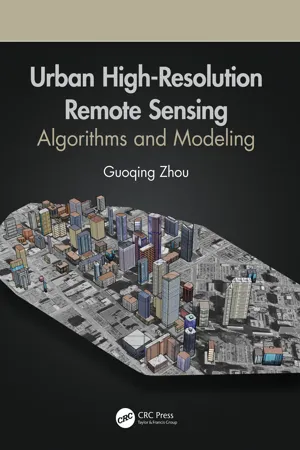
Urban High-Resolution Remote Sensing
Algorithms and Modeling
Guoqing Zhou
- 344 pages
- English
- ePUB (mobile friendly)
- Available on iOS & Android
Urban High-Resolution Remote Sensing
Algorithms and Modeling
Guoqing Zhou
About This Book
With urbanization as a global phenomenon, there is a need for data and information about these terrains. Urban remote sensing techniques provide critical physical input and intelligence for preparing base maps, formulating planning proposals, and monitoring implementations. Likewise these methodologies help with understanding the biophysical properties, patterns, and process of urban landscapes, as well as mapping and monitoring urban land cover and spatial extent.
Advanced sensor technologies and image processing methodologies such as deep learning, data mining, etc., facilitate the wide applications of remote sensing technology in urban areas. This book presents advanced image processing methods and algorithms focused on three very important roots of urban remote sensing: 3D urban modelling using different remotely sensed data, urban orthophotomap generation, and urban feature extraction, which are also today's real challenges in high resolution remote sensing. Data generated by remote sensing, with its repetitive and synoptic viewing and multispectral capabilities, constitutes a powerful tool for mapping and monitoring emerging changes in the city's urban core, as well as in peripheral areas.
Features:
-
- Provides advances in emerging methods and algorithms in image processing and technology
-
- Uses algorithms and methodologies for handling high-resolution imagery from a ground sampling distance (GSD) less than 1.0 meter
-
- Focuses on 3D urban modelling, orthorectification methodologies, and urban feature extraction algorithms from high-resolution remotely sensed imagery
-
- Demonstrates how to apply up-to-date techniques to the problems identified and how to analyze research results
-
- Presents methods and algorithms for monitoring, analyzing, and modeling urban growth, urban planning, and socio-economic developments
In this book, readers are provided with valuable research studies and applications-oriented chapters in areas such as urban trees, soil moisture mapping, city transportation, urban remote sensing big data, etc.